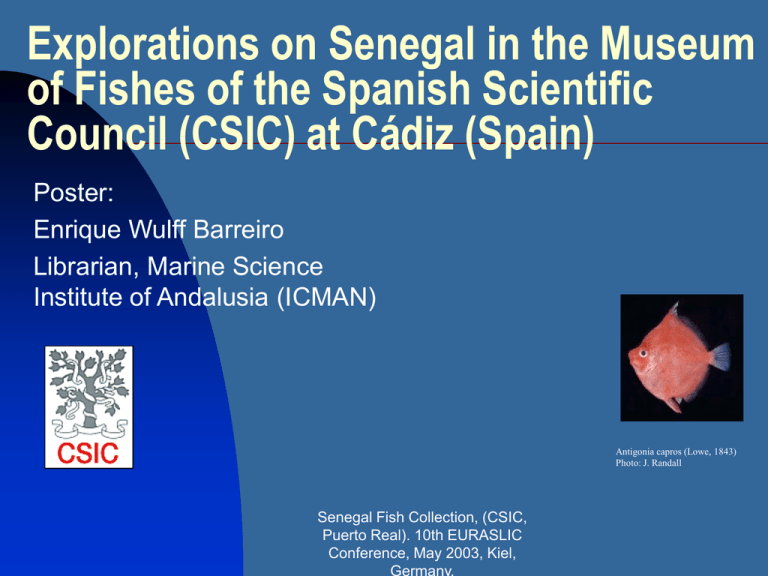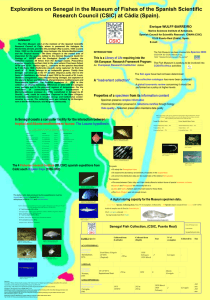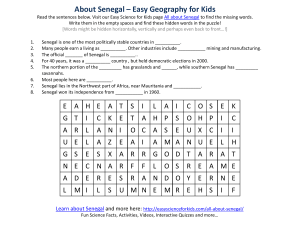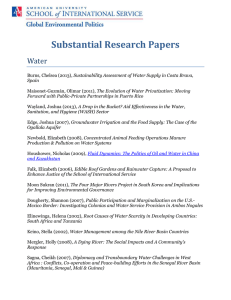Explorations on Senegal in the Museum of Fishes.ppt
advertisement

Explorations on Senegal in the Museum of Fishes of the Spanish Scientific Council (CSIC) at Cádiz (Spain) Poster: Enrique Wulff Barreiro Librarian, Marine Science Institute of Andalusia (ICMAN) Antigonia capros (Lowe, 1843) Photo: J. Randall Senegal Fish Collection, (CSIC, Puerto Real). 10th EURASLIC Conference, May 2003, Kiel, A Library of Life. A required status into the 6th European Research Framework Program. An “European Research Institution” status, into the Consortium of European Taxonomic Facilities (CETAF), for the Fish Museum of ICMAN (CSIC) The Fish Museum has been involved into Species2000: (The International Joint Workshop for Studies on BIODIVERSITY, Tsukuba, Japan, 1999 http://www-sp2000ao.nies.go.jp/english/whats_new/year_1999/pos_pre/abstract.html - ) EnriqueWulff-Barreiro The Fish Museum is seeking to be involved into CODATA Africa activities Trigla sp. (Cuvier, 1828) Senegal Fish Collection, (CSIC, Puerto Real). 10th EURASLIC Conference, May 2003, Kiel, Photo: J. Randall © This is a “Inadvertent collection” The fish ages have had not been determined. The collection catalogue has never been published. The basic activity of the museum should be to lend the models and adequately secure its retrieval. A global taxonomic review concerning it should be performed as a policy at higher levels. Senegal Fish Collection, (CSIC, Puerto Real). 10th EURASLIC Conference, May 2003, Kiel, Pagellus erythrinus (Linnaeus, 1752) Photo: C.L. Hernández-González © Properties of a specimen from its information content Specimen preserve complex information Historical information preserved in collections ramifies through biology Data quality – Specimen preservation maintains data quality Dentex filosus (Valenciennes, 1836) Photo: C.L. Hernández-González © Senegal Fish Collection, (CSIC, Puerto Real). 10th EURASLIC Conference, May 2003, Kiel, Focus: In Senegal coasts a computer facility for the interaction between tropical and Atlanto-mediterranean faunas In Senegal coastal waters the Lozano hypothesis on interaction between the tropical and the Atlanto-mediterranean fauna played a key role in spanish expeditions from CSIC Labo, sited in Cádiz, between 1958 and 1959. This “tool for the job” focuses on computer analysis of an initial sparse data region. The regional biota is described throughout the designed labeling, cataloging, and field note-taking system employed by those who created the collection. Senegal Fish Collection, (CSIC, Puerto Real). 10th EURASLIC Conference, May 2003, Kiel, Fistularia villosa (Klunzinger, 1871) Photo: J. Randall © The 4 Fisheries research Institute (IIP, CSIC) spanish expeditions from Cádiz south Bojador Cape (1958-1959) The goals: To study the Senegalese hake. To explore the abundancy and diversity of species in the zooplankton. To enrich the distribution data and the systematic of the distinct fish species. The reasons: The area between Cabo Juby and Cabo Verde offered a bottom fauna of special economic richness. Spanish and Portuguese did intensively fish in it. Cádiz and Huelva harbors were the main basis for these fleets. The Banc d’Arguin was not enough known. Senegal Fish Collection, (CSIC, Puerto Real). 10th EURASLIC Conference, May 2003, Kiel, Serranus cabrilla (Linnaeus, 1758) Photo: C.L. Hernández-González © The 4 campaigns aboard the “Costa Canaria”, the years 1958 and 1959, to the Senegal River Basin coasts. 187 fish species were caught. 1500 km, from Cape Bojador to Guinea Bissau. The fishes were studied by means of 186 trawl surveys. The main constraints afforded with by the expeditionaries was the status of the vessel employed, a fishery ship, the “Costa Canaria”. The Bathymetric distribution of the species caught in the Senegal coasts (between 16º and 12º), displays the leading idea of the expeditionaries (on fish assemblages, age, temperature and migratorial behaviors). This bathymetric data must be shared and reused, checked for errors, redisplayed within a GIS, and standardised. Senegal Fish Collection, (CSIC, Puerto Real). 10th EURASLIC Conference, May 2003, Kiel, Trachinus radiatus (Cuvier, 1829) Photo: C.L. Hernández-González © A digital storing capacity for the Museum specimen data. Basic fields: Species, Collecting from, Year, Nº of exemplars, Collected by 48 Species depicts research from Senegal (16º-12ºN) 26 were Collected from Senegal, 17 were from Mauritania (Banc d’Arguin), 4 from former Spanish Sahara coasts and 1 was caught off Guinea Bissau (10º N) Archival samples are all fixed in formaldehyde Prof. Cervigón collected 93% of the reported cases), half time working alone, half time having besides him Prof. Durán External morphology data available refers to size. Growth histories are incomplete, as in the case of many old fishes. Senegal Fish Collection, (CSIC, Puerto Real). 10th EURASLIC Conference, May 2003, Kiel, Macroramphosus scolopax (Linnaeus, 1752) Photo: C.L. Hernández-González © Dr. Fernando Cervigón Head officer at the 4 Spanish Expeditions, from Cádiz to W.Africa littoral Director The Margarita Marine Museum, Venezuela The holotype for Cottunculus costaecanariae, nov.sp. Cervigón 1961, was caught 20º45’N, 450 m, on 1958 October. Size: 139 mm Senegal Fish Collection, (CSIC, Puerto Real). 10th EURASLIC Conference, May 2003, Kiel,




